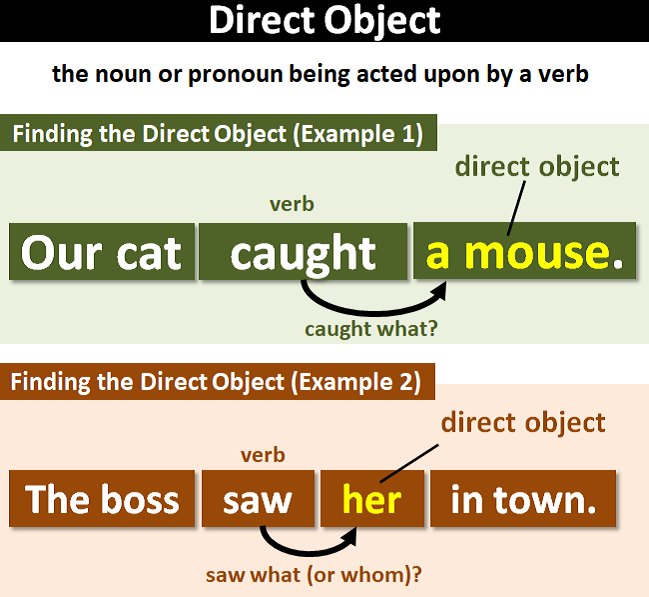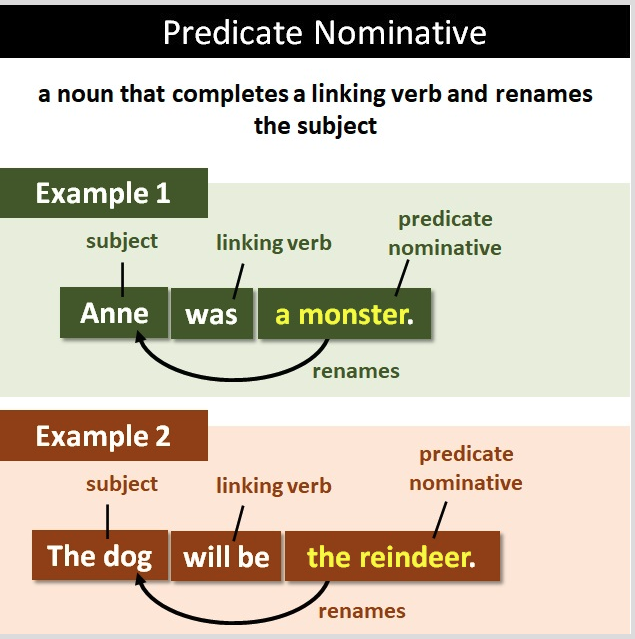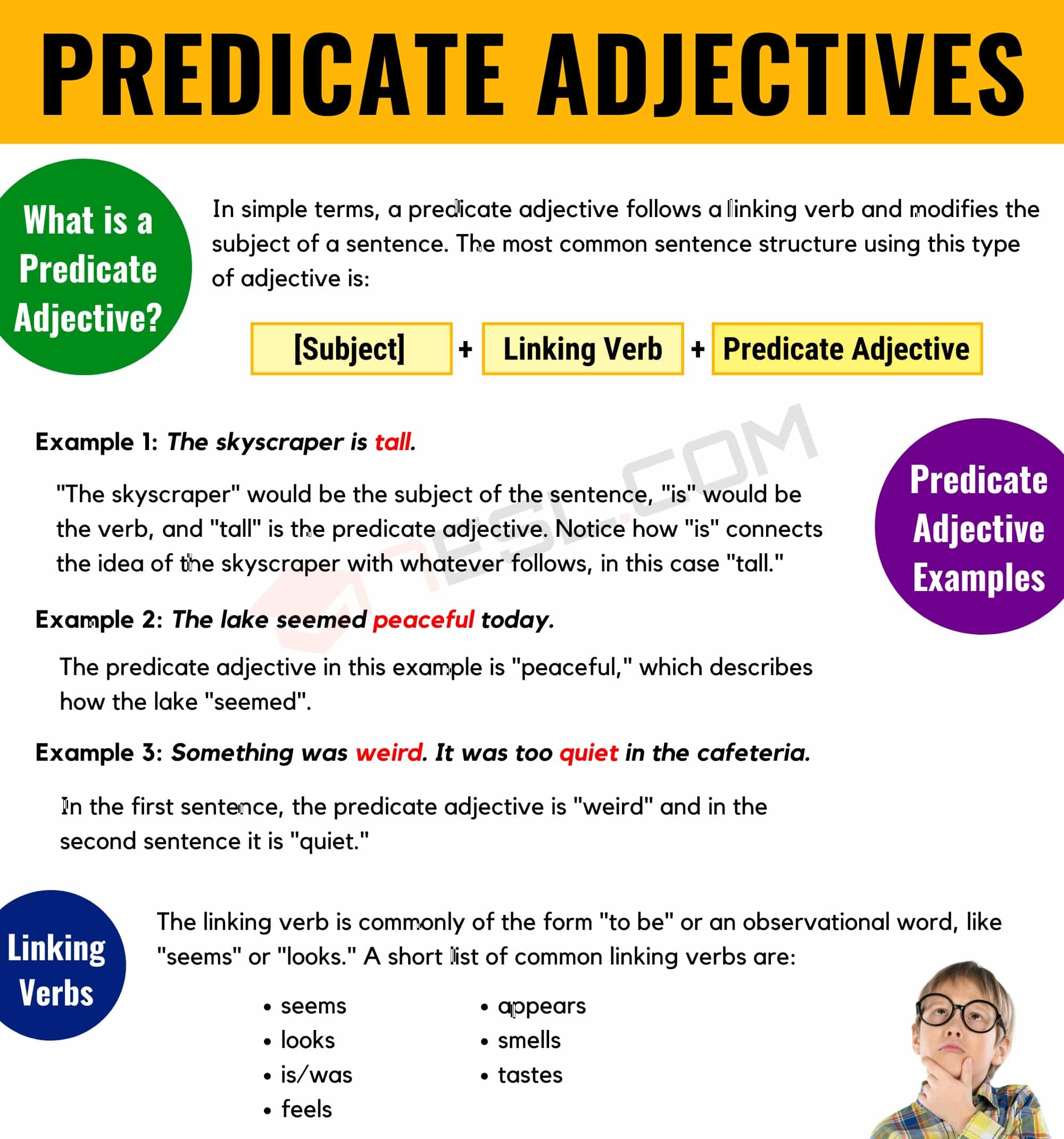ref –
- https://www.grammar-monster.com/glossary/direct_object.htm
- https://www.grammarly.com/blog/direct-object/
What Is a Direct Object?
Direct objects identify what or who receives the action of a transitive verb in a clause or sentence. When pronouns function as direct objects, they customarily take the form of the objective case (me, us, him, her, them, whom, and whomever). Consider the following sentences, taken from “Charlotte’s Web,” by E.B. White:
She closed the carton carefully. First she kissed her father, then she kissed her mother. Then she opened the lid again, lifted the pig out, and held it against her cheek.”
There’s only one subject in this passage, yet there are six direct objects (carton, father, mother, lid, pig, it), five nouns and a pronoun. Gerunds (verbs ending in “ing” that act as nouns) sometimes also serve as direct objects. For example:
Jim enjoys gardening on the weekends.
My mother included reading and baking in her list of hobbies.
Additional Information
A direct object is the noun or pronoun being acted upon by a verb (i.e., it receives the verb’s action).
For example:
Lee eats cakes.
(The verb is “eats.” The noun “cakes” is the direct object because it receives the verb’s action.)
The seagull pecked the shark’s fin.
(The verb is “pecked.” The noun phrase “the shark’s fin” is the direct object because it received the verb’s action.)

Examples
Play the guitar.
Every actor played his part.
The crowd will cheer the President.
We can climb the hill and fly the kite.
How to find the direct object
Find the verb and ask what? (or whom?).
For example:
She fed the cat.
(Step 1. Find the verb = fed)
(Step 2. Ask What? = the cat)
(Therefore, the direct object is the cat.)
Craig will read the book tomorrow.
(Step 1. Find the verb = will read)
(Step 2. Ask What? = the book)
(Therefore, the direct object is the book.)
Phrases and Clauses As Direct Objects
Direct objects aren’t always just one word;
sometimes they are entire phrases or even clauses.
These phrases always act collectively as nouns:
- standard noun phrases
- relative clauses (clauses that begin with a relative pronoun like “what”)
- gerund phrases (noun phrases that start with gerunds)
examples:
The foul ball hit a car parked outside. (clause as direct object)
Don’t forget what your mother said. (relative clause as direct object)
English professors love naming every tiny word in a sentence. (gerund phrase)
Everyone wants to eat later. (infinitive as direct object)
more examples:
Toby loves cooking scones. // gerund phrase as direct object
(Step 1. Find the verb = loves)
(Step 2. Ask What? = cooking scones)
(Therefore, the direct object is cooking scones.)
She thought that the contract had ended. // relative clause as direct object
(Step 1. Find the verb = thought)
(Step 2. Ask What? = that the contract had ended)
(Therefore, the direct object is that the contract had ended.)
The constable described what he saw at the scene. // relative clause as direct object
(Step 1. Find the verb = described)
(Step 2. Ask What? = what he saw at the scene)
(Therefore, the direct object is what he saw at the scene.)
The cat wants to eat our goldfish. // infinitive phrase as direct object
(Step 1. Find the verb = wants)
(Step 2. Ask What? = to eat our goldfish)
(Therefore, the direct object is to eat our goldfish.)
(Note: This direct object has its own verb with its own direct object.
(Question: to eat what? Answer: our goldfish.))
When a verb has a direct object, it is called a transitive verb
Some verbs do not have a direct object. They are known as intransitive verbs.
For example:
Malcolm fell very badly.
(Step 1. Find the verb = fell)
(Step 2. Ask What? = Nothing. You can’t fall something.)
(Therefore, there is no direct object. The verb to fall is intransitive.)
Joan is sleeping at the moment.
(Step 1. Find the verb = sleeping)
(Step 2. Ask What? = Nothing. You can’t sleep something.)
(Therefore, there is no direct object. The verb to sleep is intransitive.)
Direct Objects vs Complements (linking verbs)
With a linking verb, its a bit different.
If you ask what? with a linking verb, you will find that a verb complement is not a direct object.
For example:
Peter is happy.
(Step 1. Find the verb = is)
(Step 2. Ask What? = happy.)
(However, on this occasion, happy is not the direct object, it’s an adjective. This is because is (i.e., the verb to be) is a linking verb.)
However, linking verb can be followed by a direct object to form a transitive sentence:
Read about linking verbs here
What can be Direct Objects?
nouns, pronouns, noun phrase, infinitives, infinitive phrases, and clauses CAN.
Prepositional phrases CANNOT
Besides clauses and nouns, here are other grammatical units that can act as direct objects:
Pronouns: Words that replace nouns (like him, her, it, them, us, me, you, and sometimes who, whom, what).
Example: She saw him. (Him is the direct object)
Example: I like it. (It is the direct object)
Noun Phrases: A group of words that functions together as a noun. It usually includes a noun and its modifiers (like articles, adjectives, or other phrases).
Example: He bought a brand new car. (“a brand new car” is the direct object)
Example: They visited the oldest library in the city. (“the oldest library in the city” is the direct object)
Gerunds: The -ing form of a verb used as a noun.
Example: I enjoy swimming. (“swimming” is the direct object)
Example: She hates waiting. (“waiting” is the direct object)
Gerund Phrases: A gerund with its modifiers and/or objects, functioning as a noun.
Example: We finished cleaning the garage. (“cleaning the garage” is the direct object)
Example: He regrets telling her the secret. (“telling her the secret” is the direct object)
Infinitives: The “to + verb” form used as a noun (though less common as direct objects than gerunds, especially after certain verbs).
Example: He loves to read. (“to read” is the direct object)
Example: She decided to leave. (“to leave” is the direct object)
Infinitive Phrases: An infinitive with its modifiers and/or objects, functioning as a noun.
Example: They want to travel the world. (“to travel the world” is the direct object)
Example: I tried to understand the instructions. (“to understand the instructions” is the direct object)
So, in summary, direct objects can be single words (nouns, pronouns) or entire phrases/clauses that function as a single noun unit.






